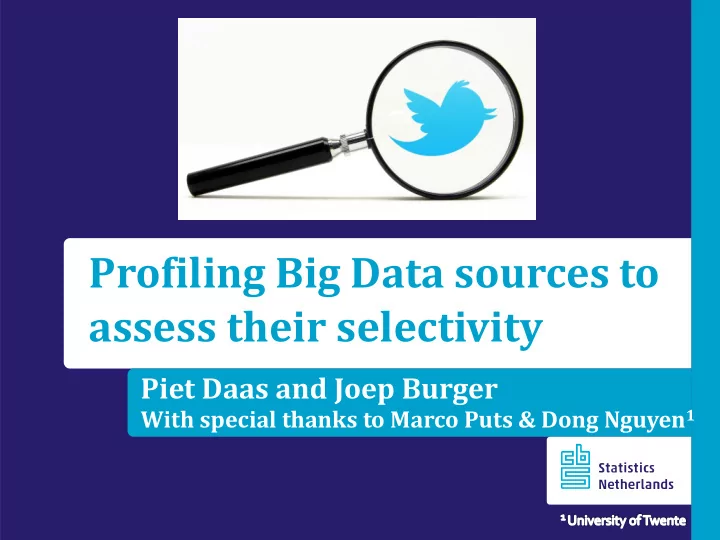

Profiling Big Data sources to assess their selectivity Piet Daas and Joep Burger With special thanks to Marco Puts & Dong Nguyen 1
Big Data – More and more organizations want to use Big Data as a new/additional source of information – However, there are some major challenges : – Selectivity of Big Data – Source does not have to completely cover the target population – What part of the population is included? 2
Profiling: extracting ‘features’ – Extract background characteristics (‘features’) from the ‘units’ in Big Data in an attempt to determine its selectivity ‐ The need for this depends on the ‘type’ of Big data source and its foreseen use – Important background characteristics for statistics are: ‐ Persons : gender , age, income, education, origin, urbanicity, household composition, .. ‐ Companies: number of employees, turnover, type of economic activity, legal form, .. 3
Social Media: Twitter as an example – On Social media persons, companies and ‘others’ can create an account and create messages ‐ In the Netherlands 70% of the population is active on social media – What kind of information is available on Twitter of a user ‐ Focus on gender! – Let’s look at a profile: @ pietdaas 4
4) Picture 3) Messages content 1)Name 2) Short bio 5
Studied a Twitter sample – From a list of Dutch Twitter users (~330.000) – A random sample of 1000 unique ids was drawn – Of the sample: ‐ 844 profiles still existed • 844 had a name • 583 provided a short bio • 473 created ‘tweets’ • 804 had a ‘non - default’ picture Default Twitter picture • 409 Men (49%) • 282 Women (33%) • 153 ‘Others’ (18%) • companies, organizations, dogs, cats, ‘bots’.. 6
Gender findings: 1) First name – Used Dutch ‘ Voornamenbank ’ website (First name database) – Score between 0 and 1 (female – male); 676 of 844 (80%) names were registered – Unknown names scored -1 (usually companies/organizations) 7
Gender findings: 2) Short bio – If a short bio is provided ‐ Quite a number of people mention there ‘position’ in the family • Mother, father, papa, mama, ‘son of’, etc. ‐ Sometimes also occupations are mentioned that reflect the gender (‘ studente ’) ‐ 155 of 583 (27%) indicated there gender in short bio ‐ Need to check both English and Dutch texts 8
Gender findings: 3) Tweets content – In cooperation with University of Twente (Dong Nguyen) – Machine learning approach that determines gender specific writing style ‐ Language specific: Messages need to be Dutch! ‐ 437 of 473 (92%) persons that created tweets could be classified
Gender findings: 4) Profile picture 1 3 2 – Use OpenCV to process pictures 1) Face recognition 2) Standardisation of faces (resize & rotate) 3) Classify faces according to gender 10 - 603 of 804 (75%) profile pictures had 1 or more faces on it
Gender findings: overall results Diagnostic Odds Ratio (log) Diagnostic Odds Ratio = (TP/FN) / (FP/TN) First name 6.41 Short bio 3.50 random guessing Tweet content 2.36 log(DOR) = 0 Picture (faces) 0.72 ‐ Multi-agent findings • Need clever ways to combine these • Take processing efficiency of the ‘agent’ into consideration 11
Thank you for your attention ! 12
Recommend
More recommend